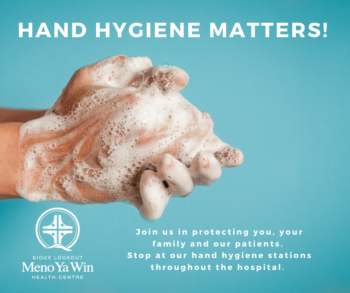
We Take it Seriously
Here at SLMHC, our staff and physicians are trained on proper hand hygiene and the Four Moments of Hand Hygiene.
Join us in practicing good hand hygiene! When visiting SLMHC, help prevent the spread of infection by using one of our hand sanitation stations located throughout our facilities!

Hand Hygiene
Here at SLMHC, we take hand hygiene seriously. Hand hygiene is cleaning your hands to stop the spread of germs. Please wash your hands when you: enter the hospital building, before and after every contact with a patient, before and after eating, after using the washroom and when leaving the building.
Hand sanitizer stations are located throughout the hospital to help with this. Hand sanitizer stations are effective if your hands are visibly clean, however if your hands are soiled or visibly dirty use soap and water in one of our washrooms located throughout the facility.
SLMHC regularly monitors and reviews hand hygiene rates of our staff and physicians, and uses this information to execute best practice protective measures and continually improve patient care and safety.
Access our hand hygiene rates or more information on hand hygiene in healthcare settings.
FAQs
What is MRSA?
It is a type of a bacteria that is resistant to certain or all types of the betalactam classes of antibiotics such as penicillins, penicillinaseresistant penicillins (e.g. Cloxacillin) and cephalosporins.
Risk factors for MRSA acquisition include procedures, prior treatment with antibiotics, prolonged hospital stay, stay in intensive care of burn units, surgical wounds and close proximity to a colonized person. MRSA can also be transmitted from mother to child through breast milk.
What is VRE?
Enterococci are bacteria that are normally present in the human intestines and in the female genital tract and are often found in the environment. These bacteria can sometimes cause infections. Vancomycin is an antibiotic that is often used to treat infections caused by enterococci .In some instances enterococci have become resistant to this drug and thus are called vancomycin resistant enterococci (VRE).
Risk factors for VRE include underlying disease, presence of invasive devices, prior colonization with VRE, antibiotic use and length of hospital stay.
How are MRSA and VRE transmitted?
The single most important mode of transmission of MRSA and VRE in a health care setting is via transiently colonized hands of health care workers who acquire it from contact with colonized or infected patients, and or handling contaminated material and equipment. The unrecognized colonized presents a particular risk for transmission to other patients.
What is C. difficile?
C. difficile is one of the many types of bacteria that can be found in feces (bowel movement), and has been a known cause of health care associated diarrhea for about 30 years.
Where does C. difficile come from?
C. difficile is not new. Although people may lately associate it with health care settings, it doesn’t come from hospitals, longterm care homes or laboratories. It is widely distributed in the environment and can be found in the human intestine, occurring naturally in 35% of adults (more commonly in the elderly) without causing symptoms.
What causes C. difficile?
C. difficile can be picked up on the hands from exposure in the environment and can get into the stomach once the mouth is touched, or if food is handled and then swallowed. Once in the stomach, the bacteria usually will not cause any problems unless the other bowel bacteria are disturbed, which can happen when antibiotics are taken.
The use of antibiotics increases the chances of developing C. difficile diarrhea as it alters the normal level of good bacteria found in the intestines and colon. Without the presence of the normal bowel bacteria, the C. difficile bacteria may start to grow and produce a toxin that can damage the bowel and lead to watery diarrhea, fever and abdominal pain or tenderness.
How does C. difficile spread?
When a person has C. difficile, the bacteria in their feces can contaminate surfaces such as toilets, bedpans, commode chairs, and door handles (if feces is on hands). Othe,r healthy individuals can be contaminated if their hands touch these items. If these individuals then touch their mouths without washing their hands, they can become infected.
C. difficile produces spores that survive for long periods and are resistant to destruction by many environmental factors (e.g. temperature, humidity).
Hand hygiene: everyone’s responsibility Good hand washing by everyone, healthcare staff, physicians, volunteers, patients and visitors, is the single most effective way to prevent the spread of infectious diseases like C. difficile.